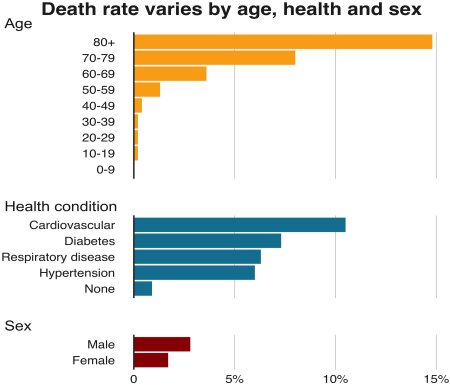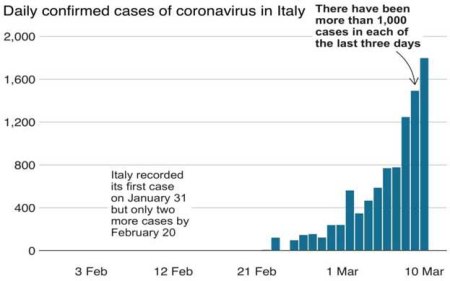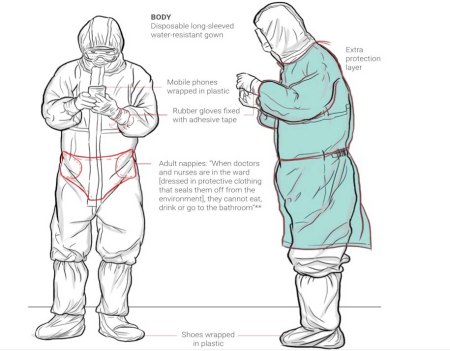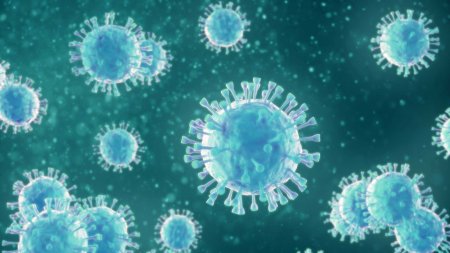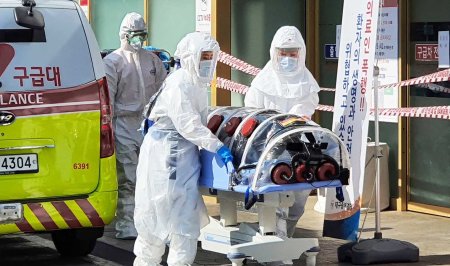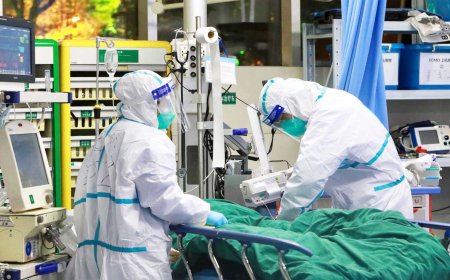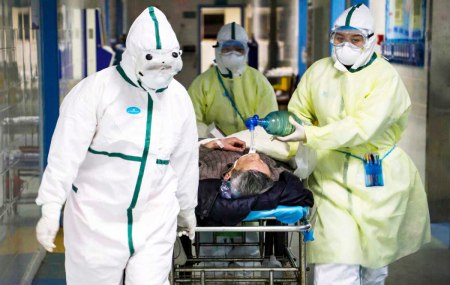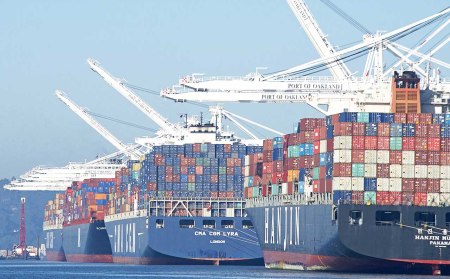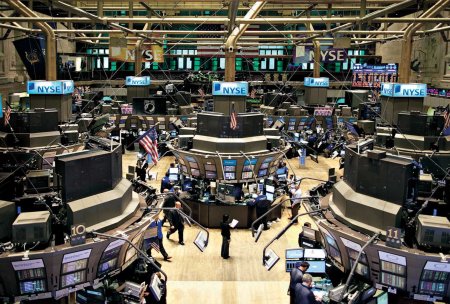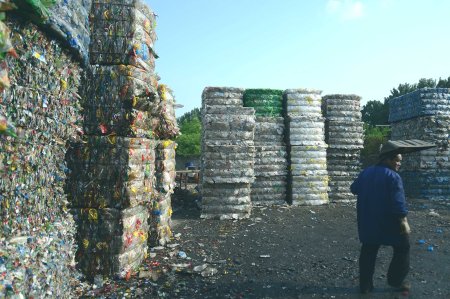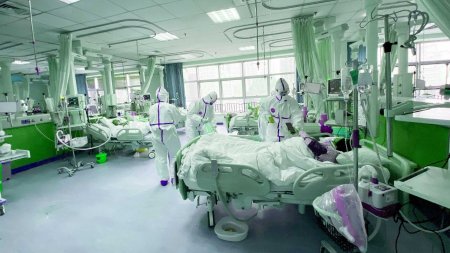It is impossible to predict, how the coronavirus pandemic will end, but here is a first assessment including details which are omitted in mass media.
We know, that symptoms like dry cough and fever can appear anywhere between two and 14 days after infection and that there are individuals who carry the virus but show no symptoms. A German study suggests that people who test positive are most contagious before they’ve started exhibiting symptoms and during the first week that symptoms show up.
The epidemiological characteristics of the virus arise from high viral loads in the upper respiratory tract and the potential for persons infected with SARS-CoV-2 to shed and transmit the virus while asymptomatic. Test results indicate that aerosol and fomite transmission of SARS-CoV-2 is plausible, since the virus can remain viable and infectious in aerosols for hours and on surfaces up to days.
This means that the virus will spread quickly in malls, supermarkets, offices, and public transport, as the ubiquitous air-condition units and ventilators distribute germs efficiently.
Face masks (N95 respirator) can protect against infections, the best protection though is avoiding public places. Even online shopping bears risks, as infected persons who packed and delivered the goods left fomite on surfaces (plastic, metal). One best handles incoming parcels only with gloves and puts them aside for a few days to let possible germs die.
It is not clear yet how long a person who was infected and recovered is immune against the virus. There are a few reports that individuals who contracted the disease and recuperated have tested positive again.
Crucial answers about immunity to SARS-CoV-2 won’t come from the RNA-based diagnostic tests now conducted by the tens of thousands. These tests look for the presence of viral genes in a nose or throat swab, sign of an active infection. Yet, only a blood test for antibodies to the virus SARS-CoV-2 will tell whether a person has been infected in the past because the body retains antibodies against pathogens it has already overcome.
Blood tests could also help identify recovered patients who could then donate their SARS-CoV-2 antibody-rich serum to help treat critically ill patients. Another key application would be to identify people who have developed likely immunity to the virus. They might be able to treat patients safely or take on other front-line jobs during the pandemic. Test data could inform practical issues such as wether and how to reopen schools that have been closed. Relatively few cases have been diagnosed among children, but it isn’t clear whether that’s because they don’t get infected or because their infections are generally so mild that they go unnoticed. Testing children for SARS-CoV-2 antibodies should resolve that.
Most deaths are among people 65 and older, but younger persons also get seriously ill, though they are more likely to be saved with heavy-duty intervention. The survivors will probably retain permanent damage, like reduced lung function and a compromised immune system.
A new, not yet peer-reviewed study indicates greater transmission in cooler climates, and a hot summer could slow down the pandemic. In Australia though, hot weather didn’t help, as numbers rise like everywhere else, forcing the government to close pubs, clubs, gyms, cinemas, and places of worship to slow the spread of infections.
What’s going on?
Worldwide, nations try a combination of various antiviral treatments (remdesivir, lopinavir, ritonavir, descovy, chloroquine), blood plasma infusions from survivors, and vaccines, being fast-tracked to help treat cases. There is an increasing effort to slow the spread and “flatten the curve” by “social distancing,” quarantines, and shutting down transport and businesses.
Despite these efforts, the numbers of SARS-CoV-2 infections and of resulting deaths are increasing exponentially, reaching double, triple, and quadruple digits in just a few days. At the moment, we speak about thousands, but soon we may speak about millions. Only China and South Korea seem to have the situation under control.
In most countries there is a shortage of testing kits. There are also not enough ventilators and protecting masks (N95).
The numbers from Italy, Iran, China, and most other paces are surely an underestimation. There is a huge number of infected who are asymptomatic. The fast growing cases of infected doctors, medics, and nurses are especially alarming.
Efforts to contain the disease face limitations of national heath systems which, despite warnings by the international scientific community for 20 years, are so starved of funds that they cannot adequately deal with standard operations, let alone a historic health emergency.
After decades-long austerity policies have slashed health budgets and closed down smaller regional hospitals, many countries have to convert now hastily entire hospitals to infectious disease treatment units, which results in severe contamination of recently converted units, as these sections were not originally set up for infectious diseases.
As cases spike, health officials are conceding that the battle to contain the virus is lost, and are hunkering down for an onslaught, directing scarce resources where they are needed most to save lives. Doctors need to make harsh choices about whom to save (triage), meaning: the elderly are sacrificed.
Turkey’s public health system for example has been systematically gutted and privatized over the past two decades. While Turkey has 25,466 adult beds (almost half in private hospitals) in its intensive care units, it has just 187 doctors per 100,000 people. This figure is 399 in Italy, the worst-affected country in Europe, and 607 in Greece.
Nurses and doctors in Italy issue desperate pleas for more of the most basic medical equipment. The number of patients in critical condition far surpasses the available equipment. There are pictures of helpless patients suffering quietly and awaiting death. A shocked reporter wrote: “They are fighting a war here and they are losing. The sheer numbers of people succumbing to the coronavirus is overwhelming every hospital in northern Italy.” 23 Italian doctors have died since the pandemic began.
Patients with other life-threatening illnesses are worried that they will not be able to get needed treatment and surgeries as the hospitals are overwhelmed. The psychological impact is incalculable. After reporting another shocking jump in deaths, the Italian government has ordered a complete shutdown of industrial production for 15 days.
Due to the escalation of the crisis in Britain, in the space of a few days Boris Johnson’s Conservative government has gone from doing virtually nothing over the pandemic — as it advocated a policy of letting the entire population be infected and supposedly acquire “herd immunity” — to imposing firstly social distancing measures and then ordering closure of all cafes, bars, pubs, restaurants, nightclubs, theaters, gyms, cinemas, and leisure centers.
Even the USA, richest nation of the word, is in the midst of a full-blown public health crisis made worse by underfunding and privatization. An Imperial College London study predicts 2.2 million US deaths, assuming that no one dies from not getting treatment. Yet, as the USA doesn’t have an adequate healthcare system, there could be more than 10 million deaths.
Like most other nations the USA has implemented quarantine and social distancing, but some Republican politicians argue that the economic effects of social distancing have become too severe and that workers should go back to their jobs.
Many large metropolitan areas have missed the critical containment window, not implementing social distancing measures to suppress the epidemic curve, resulting in mass community spreading, and now an exponential increase in severe cases.
In the Middle East Kuwait imposed a curfew between 5pm and 4am and the UAE has closed beaches and parks for two weeks. Syria has its first SARS-CoV-2 case in the Al Muasat Hospital, Damascus, and the government has ordered the closure of schools, restaurants, gyms, and other gathering places. Busses and the Damascus airport are constantly disinfected.
Conspiracies abound
There is indeed a lot to question and consider, but in the end all speculations, worries, warnings, or predictions are meaningless, as the pandemic mercilessly moves forward. The reader may as well skip this section of the text.
Steven Soderbergh’s 2011 virus thriller “Contagion” has become one of the most rented titles on iTunes and the second most-watched movie in Warner Bros.’ catalogue. It is interpreted and explained in creative ways. The parallels to the current pandemic are astounding and prove, that this pandemic was not unimaginable, that intelligent and educated people could foresee it.
On October 18 last year, the Johns Hopkins Center for Health Security in partnership with the World Economic Forum and the Bill and Melinda Gates Foundation hosted Event 201, a high-level pandemic exercise, in New York. The simulation modeled a fictional coronavirus pandemic, but explicitly stated that it was not a prediction. This is more prove that influential people discussed the possibility of a pandemic and the question remains, why nobody called for adequate preparations.
The lone microbiology lab in China that handles viruses like the coronavirus is located in Wuhan, and one prominent rumor claims that SARS-CoV-2 escaped from this lab while biologists were studying bat coronaviruses.
The online conspiracy community asks:
Why needs the White House messaging control, with Vice President Mike Pence’s requesting control of all statements in regard to the coronavirus. Does the US administration need to hide something?
Why did the USA in 2001 withdraw from the 1972 BTWC (Biological and Toxin Weapons Convention)? Why did it try to prevent a monitoring mechanism for the execution of the convention?
Why are there new biological laboratories in Georgia, Ukraine, Moldova, Armenia, Azerbaijan, Uzbekistan and Kazakhstan? Are those labs for biochemical warfare?
Why was the US Army Medical Research Institute of Infectious Diseases, located in Fort Detrick, Maryland, shut down in July 2019. Was it because there was a virus leakage incident? Why did the US erase huge number of English news reports on the internet covering the shutdown in March 2020?
And worried commentators warn:
There is no doubt that the ruling elites in most countries will use the coronavirus crisis to push for expansive emergency powers.
The US Department of Justice has asked Congress for the ability to go directly to chief judges in order to detain people indefinitely without trial during emergencies. There are fears that President Donald Trump will use this moment of crisis to further restrict civil rights, and he has indeed cited the pandemic as a reason for heightening border restrictions and restricting asylum claims. US courts have already ground to a halt as jurors are not coming in and face-to-face depositions are not happening.
Some nations could also see a declaration of martial law, where constitutional freedoms and liberties are suspended, and civilians are no longer entitled to their civil rights. Martial law allows a government, or a tyrannical political elite, to ignore the constitution and impose its will through military force.
In the USA, secret contingency plans exist for what the military is supposed to do if all the Constitutional successors are incapacitated. Standby orders were issued more than three weeks ago to ready these plans, not just to protect Washington but also to prepare for the possibility of some form of martial law.
The various plans – codenamed Octagon, Freejack, and Zodiac – are the underground laws to ensure government continuity. Under these extraordinary plans, “devolution” could circumvent the normal Constitutional provisions for government succession, and military commanders could be placed in control around the USA.
Pest control
Some 10,000 years ago, wild animals were the overwhelming majority and humans made up only one percent of the animal population. In 2011, humans constituted 32 percent and wild animals one percent of living creatures. About 67 percent of non-wild animals were food for humans.
The missing wild animals, even the tiniest, were the species that kept the Earth beautiful, fruitful, habitable, and alive. The wild animals disappeared because humans hunted them, destroyed their habitat, and poisoned them.
Speciesism is the idea that being human is a good enough reason to claim greater moral rights than non-human animals. Australian philosopher Peter Singer defines it as “an attitude of bias against a being because of the species to which it belongs.”
Speciesism has a long tradition. The Bible, Genesis 1:28, states: “And God blessed them. And God said to them, Be fruitful and multiply and fill the earth and subdue it, and have dominion over the fish of the sea and over the birds of the heavens and over every living thing that moves on the earth.”
This attitude of human superiority and unbridled domination is a leading cause of our current ecological crisis. UN climate experts say humanity has about a decade to prevent “irreversible damage” to the world from the monster of anthropogenic climate change.
It will get worse, as climate change, drought, floods, deadly storms, and earthquakes will destroy the livelihood of millions. 145 million Africans are on the brink of famine, the UN says. The deserts of Syria, Iraq, and Iran are constantly expanding. The Gaza strip, Israels main concentration camp for the Palestinians, has become “unlivable,” Yemen is running out of water, and the whole Arab Peninsular will become unlivable too because of unbearable heat.
Habitat destruction, mass extinction (loss of biodiversity), poisoning of the biosphere, collapse of ecosystems (oceans, rainforests, wetlands), and climate change are threatening life on this planet, but Mother Nature (Gaia) is fighting back and uses two strategies which have always worked to eliminate pests.
One method uses a contagious disease to wipe out large numbers of a pest, the other method let the pest destroy its own food base.
No mercy
People in displaced persons camps in northern Syria or in the refugee camps on the Greek islands Lesbos, Chios, Samos, and Kos are left to fend for themselves. The overcrowded camps will quickly be transformed into death camps, if the coronavirus gets a hold there.
Intolerable hygienic conditions in the camps prevent even the most basic protective measures from being adopted. In some camps there is just one water tap for thousand people, and no soap is available. Five- and six-person families barely have three square meters of space. There are no permanent structures for accommodation, and many displaced persons or refugees spend the night under plastic sheeting.
Conditions resembling a war zone predominate on the Kastanies and Pazarkule crossings at the Turkish-Greek border. Greek security forces target refugees with tear gas, flash grenades, rubber bullets, and sometimes even live ammunition. Around 10,000 people continue to huddle in makeshift tents in no-man’s-land without any provisions. Since the Turkish police refuses to let them back into Turkey, they are left totally exposed to violence.
SARS-CoV-2 is a special threat also to millions of incarcerated people. Iran released 85,000 prisoners with 10,000 more slated to receive pardons, as fears mounted, that the new coronavirus could sweep through the country’s overcrowded prisons.
The coronavirus is also invading US jails and prisons, prompting inmate releases, reduced bail requirements, and other extraordinary measures as officials rush to avert a potentially disastrous spread of the virus among crowded inmate populations. The USA has the words largest prison population with 2.3 million incarcerated.
On Riker’s Island, the US’s second-largest prison, 21 inmates, 12 jail employees, and five correctional health workers have tested positive. One worker at the complex has died.
As competition trumps cooperation anytime, the Trump administration quietly offered a huge sum of cash to a German pharmaceutical firm in order to secure exclusive control, access and supply of any coronavirus vaccine it created, making sure it was available only on a for-profit basis. This enraged the German government; “Germany is not for sale,” declared economy minister Peter Altmaier.
US pharmaceutical company Gilead, which owns a promising SARS-CoV-2 vaccine, is involved in a legal battle with the Chinese government to deny them the right to any potential vaccine, arguing that the Chinese would likely give it away free to the world, thus destroying Gilead’s profits.
International solidarity is rare, and Italy’s appeal for help to the European Union found deaf ears. Not a single EU member state sent Italy the desperately needed supplies. Not only that, a shipment of 680,000 Chinese face masks to Italy was stolen in the Czech Republic, whose government initially denied that anything had got lost.
China, Cuba, and Russia had to fill the void. A Chinese plane with nine medical experts and 31 tons of medical supplies including intensive care unit equipment, medical protective equipment, and antiviral drugs arrived in Rome, a Chinese truck only a few days later brought more than 230 boxes of medical equipment.
The Russian army is flying medical help to Italy. At least three giant Il-76 military planes landed in Pratica di Mare military airbase near Rome after receiving an order from President Vladimir Putin. Six more planes as well as trucks with medical specialists, testing, and disinfecting equipment are on the way.
Cuba dispatched a 52-strong team of doctors and nurses to Italy after the worst-affected region, Lombardy, asked for immediate assistance. This is the sixth medical brigade Cuba has sent in recent days to combat the spread of the disease abroad. It has sent contingents to allies Venezuela and Nicaragua as well as to Jamaica, Suriname, and Grenada.
Cuba also allowed coronavirus-stricken British cruise ship MS Braemar to dock in Havana, so that British passengers, confined on the ship for days, were able to disembark and fly home. A number of other Caribbean countries, including the Bahamas and Barbados, refused.
Cuba has developed and produces a number of medicines including the anti-viral drug Interferon Alpha 2B, which could save thousands of lives in the pandemic. The medicine is also produced in China in a Cuban-Chinese joint venture and so far has managed to effectively treat and cure more than 1,500 coronavirus patients.
China just delivered the first 2000 testing kits to Syria.
The USA expanded and tightened sanctions against Iran, Venezuela, and Syria, making the delivery of medicine and medical equipment from Western nations impossible. It will not make much difference, because solidarity or even compassion in not in the playbook of Western international relations. If Italy’s pleas for help were ignored by its Western allies, why should Iran, Venezuela, and Syria be treated any better?
Industrialization dead end
Whilst contagious diseases have always been a part of the human experience, the expansion of industrial civilization has inexorably amplified the risk of epidemics and pandemics.
Uncontrolled industrial expansion also dangerously heats the planet and drives the collapse of ecosystems worldwide. Experts like Professor Jem Bendell and philosopher Rupert Read have argued that societal collapse is near inevitable and that up to 6 billion people could die.
A slowing economy is a lower-carbon economy. In China, coronavirus slowed industrial production, prompted longer holidays, and led to the introduction of travel restrictions, all of which resulted in lower CO2 emissions: China’s emissions are down by a quarter, or 100 million metric tons. Nitrogen dioxide emissions, produced mainly by diesel vehicles, dropped even by 40 percent.The decrease in output means less material is being shipped across the world, and less disposable products are ending up in landfills.
A preliminary calculation by a US expert suggests that tens of thousands of premature deaths from air pollution may have been avoided by the cleaner air in China, far higher than the coronavirus death toll.
The sort of precipitous and unmanaged decline which coronavirus has forced on global economies can devastate people’s livelihoods and living standards. However it is possible to implement such measures in a steady way, and forge societies less dependent on industrial production that not only protect livelihoods but simultaneously increase citizens’ well-being. This is what economists and sustainability experts call degrowth: a “phase of planned and equitable economic contraction in the richest nations eventually reaching a steady state that operates within Earth’s biophysical limits.”
While coronavirus has resulted in a very sudden scale-down in industrial production due to a public health emergency, living through this spasm may allow citizens to imagine, and policy-makers to plan, how it is possible to live differently in response to the ecological emergency. Reducing economic activity and industrial output is a means to enable global ecosystems to regenerate.
The religion of permanent growth
The strategy of “flattening the curve,” of slowing the spread of the virus so that the healthcare system isn’t overwhelmed, could bring the mortality rate down by matching healthcare need to capacity. Implied in the structure of the now applied economic stimulus packages is not more than a couple of weeks at home watching TV shows, YouTube, or social media sites, and then it’s back into the rat race.
But this is a low probability outcome. Experts anticipated a 18 months duration of the pandemic, if effective action to mitigate is taken, which means that a radically changed world will emerge after we have gone through this.
Angel Gurria, OECD secretary general, said economies were already suffering a bigger shock than during the 9/11 terror attacks or the 2008 financial crisis.
He said: “And the reason is that we don’t know how much it’s going to take to fix the unemployment because we don’t know how many people are going to end up unemployed. We also don’t know how much it’s going to take to fix the hundreds of thousands of small and medium enterprises who are already suffering.”
Mr Gurría called on governments to rip up borrowing rules and “throw everything we got at it” to deal with the crisis. However, he warned that bigger deficits and larger debt piles would also weigh on heavily indebted countries for years to come.
When bureaucrats, economist, and politicians speak about securing jobs, what they really mean is securing profits. It’s not about worker’s happiness, it’s about shareholder happiness.
Workers in car factories have to keep the production lines going. Volvo announced that it is back to normal in China, but had to close EU and US car plants. GM, Ford, Fiat Chrysler, Nissan only closed their US plants after wildcat strikes and walkouts.
Starbucks workers, including those with dry coughs and those just off international cruises, were told they couldn’t take paid sick leave, despite what one may have read about Starbucks’ policies, because those policies require proof of a positive test result for coronavirus or proof that the employee had been directly exposed to someone who’d been specifically diagnosed with coronavirus. Workers were told they’d get paid leave if the company would shut down their whole store; but an employee told journalists that when their mall location was shut they were just reassigned to another one nearby.
The synchronized shutdown of heavy industry in Europe and the USA is unlike anything seen since the 1930s, and the economic and social crisis, which began with the shutdown of a significant portion of China’s economy and the disruption in the global supply chain, has now spread around the world as restaurants, retailers, airlines, public schools, and factories close or sharply curtail operations.
For the second time in little over a decade, the world economy is in a state of breakdown, this time on a far greater scale than 2008-09. Investment bank Goldman Sachs expects the US economy to contract by an unprecedented 24 percent in the second quarter of the year (April-June), as production and service industries grind to a halt. This would be the largest quarterly contraction in US history, far surpassing even what took place during the Great Depression. Then the jobless rate peaked at 24.9 percent in 1933. According to Moody’s Analytics, nearly 80 million jobs (more than half of US jobs) are at risk due to the coronavirus.
There will be also a vast expansion of underemployment as working hours and wages are reduced. With half of US adults living paycheck to paycheck and 53 percent reporting that they don’t have savings that cover at least three months of expenses, the loss of a job means destitution.
While the pandemic has triggered the crisis, the causes of the economic breakdown lie far deeper. The process of financialization (the systemic and unrestrained separation of the accumulation of staggering levels of wealth from real productive activity) created a massively unstable global economy, based on the unlimited transfusion of liquidity by the central banks (i.e., quantitative easing) to drive up the equity markets to ever more unrealistic and unsustainable levels.
So, here we are again being told by the in 2008-09 bailed out that the governments have to bail out corporations and the rich to save the economy.
Up to this point, the US government has spent less than 10 billion US$ on emergency disaster relief related to the pandemic, while the US Treasury has purchased some 600 billion in securities in recent weeks, meaning it has spent 60 times more money propping up the banks than on addressing the healthcare crisis. Right now a bill is stuck in Congress, expected to cost 1.8 trillion US$ or more. Less than 50 billion US$ of the bill funds emergency measures to combat the pandemic. Just one company, Boeing, is demanding a bailout larger than every public health measure contained in the bill.
This is the American way. While the US military is wildly overfunded, the healthcare system is starved and structured to let people die at a politically acceptable pace. During a crisis, a hierarchy of privilege is set in motion: First, save the wealth of the rich through bailouts. Second, secure the rights of corporations to profit from catastrophe. Last, save just enough citizens to uphold the illusion of a still valid social contract.
The Federal Reserve (US central bank) just announced open-ended QE (quantitative easing) to keep the markets functioning. In addition to that, the Federal Reserve will buy more bonds to calm markets and will buy corporate debt in a series of emergency lending programs. As usual: Socialisms for the rich, capitalism for the poor. To protect jobs and wages, they say, when in reality it’s to protect profits, shares, and other financial assets of the billionaires.
All this bailout money is fiat money, created with a few computer clicks and not secured by any real assets. It just will increases the debt burden. The US official budget deficit has reached a trillion US$. US national debt is 23 trillion US$. Household debt in the fourth quarter of 2019 rose 4.4 percent. Student debt increased to 1.60 trillion US$, auto loans rose to 1.3 trillion US$, while credit card debt rose to a record 930 billion US$. In 2019, the USA paid 600 billion US$ just on debt interest, nearly 9 percent of its total spending.
Many industrial countries are in a similar predicament. Italy has a debt-to-GDP ratio above 130 percent and Italian banks are vulnerable (Monte Dei Paschi Di Siena). This will become an unsolvable problem for the ECB (European Central Bank).
The Dollar is still strong, it is still the reserve currency, it is still the “petrodollar,” but one day lenders will realize that debt which cannot be payed will not be payed. Then the bond market will unravel, the derivatives will unwind, the global financial system will crash and come to an end.
Pandemic capitalists
SARS-CoV-2 might be destroying the economy and kill millions, but in crisis there is also opportunity. Top US congress members — including Republican senators Richard Burr, Kelly Loeffler, and Democratic Senator Dianne Feinstein — dumped exposed shares while at the same time hiding the severity of the pandemic from the population.
The most blatant and criminal example of insider trading came from the Senate’s newest member Kelly Loeffler, who was appointed to fill a vacancy this year. Loeffler is worth an estimated 500 million US$, in large part due to her role as former executive and stockholder at the ICE (Intercontinental Exchange). Between January 24 and February 15, Loeffler dumped stock jointly owned between her and her husband worth between 1.3 and 3.1 million US$.
There is also opportunity for Joshua Kushner, brother of Jared, son-in-law and senior advisor to President Donald Trump. Joshua is the co-founder of Oscar Health, a huge medical company that this week launched a test center locator for SARS-CoV-2, where users input their data and are directed to one of many locations where they can receive a test. It is highly likely that medical companies will be later reimbursed by the government for any services they provide.
Industrial agriculture dead end
Factory farms, which raise billions of animals per year in squalid, cramped, and unhygienic conditions, are ideal breeding grounds for infectious diseases. The deadly 2009 swine flu pandemic sprang out of a massive pig farm in Veracruz, Mexico, where hundreds of pigs died in an outbreak that eventually moved into people.
Mandy Carter, Global Senior Campaign Manager at Compassion in World Farming, said: “Intensively farmed animals live in crowded, barren conditions deprived of even the most basic natural behaviors. Given the number of animals involved and their lifelong suffering, factory farming is one of the biggest causes of animal cruelty on the planet. And not only does it harm animals — it hurts the natural world and us too.”
Wendy Orent, the author of “Plague: The Mysterious Past and Terrifying Future of the World’s Most Dangerous Disease” writes: “If we want to forestall the evolution of ever-newer, and possibly deadlier, human-adapted viruses, live animal markets must be permanently shut down … until factory farms housing millions of animals are eliminated, until we take the inevitable logic of disease evolution into account, novel and potentially deadly, human diseases will continue to arise. Again. And again. And again.”
Factory farmed animals are fed feed like soy or corn, grown on exhausted soil with a vast input of chemicals (nitrogen, phosphorus, potassium fertilizer, pesticides, and fuel for farm machines). Feed is also grown in the last remaining habitats of the world’s wild animals (Amazon rainforest, Indonesian and Congo Basin rainforests). Factory farming animals is increasingly seen by scientists, health experts, and opinion leaders as an abomination that has to be stopped.
Urbanization dead end
Maybe humans shouldn’t have tried to organize themselves into groups exceeding the Dunbar number, which anthropologist Robin Dunbar showed was about 150 people, the size of hunter-gatherer groups. Dunbar also showed that’s roughly the size of groups in which human beings are comfortable today.
More and more people live in cities and eat food that has been industrially-produced elsewhere and trucked, flown, or shipped in using fossil fuels. Intensive food production and perpetual long-distance shipping makes the spread of diseases more likely. Furthermore, the loss of nature and the increase of monocultures enable disease pathogens to thrive.
The more urbanized and industrialized a country becomes, the more trash it produces. The rapid rate of urbanization has exacerbated waste management in big cities, and, according to a UN report, their public waste systems often can’t keep up with the sprawling growth of suburbs. The world’s 27 megacities produce 12 percent of global waste, as a PNAS study from 2015 found.
According to the Global Footprint Network, “In many countries, one or two major urban centers are major contributors to the national Ecological Footprint and also run significantly higher per capita footprints than the average for their nations.”
There’s no doubt that cities provide more job opportunities than rural places, more entertainment, and more distraction. But city dwellers are also completely dependent on communal services (which may fail in a crisis), fossil fuels, supermarkets, and detached from nature.
Small remote villages can be based on small-scale agroecology, co-ops, and neighborhood collaboration — such schemes are difficult or even impossible in cities.
Higher population density means easier spread of contagious diseases and the health damage inflicted on people by long-standing air pollution in cities is likely to increase the death rate from coronavirus infections.
Tourism dead end
With the Diamond Princess now as synonymous with the virus as Wuhan province, the last place people are dreaming of being right now is on a cruise ship, and bookings for the 45 billion US$ a year cruise industry are down 40 percent.
Cruise ships emit extreme pollution in some of the world’s most beloved and fragile ecosystems such as the arctic, Caribbean Sea, and Galapagos Islands. Burning the world’s dirtiest oil (bunker fuel) they pollute the air and cause sickness among coastline communities. The European fleet of the world’s single biggest cruise company, Carnival Corporation, emits 10 times more SOx air pollution along Europe’s coasts than all of Europe’s cars.
Until these giant corporations address their impacts, a drop in bookings for this monstrously polluting sector can only be a good thing in regard of natures health.
Similarly, air travel is down due to coronavirus, declining for the first time since 2009 with an estimated cost to airlines of 113 billion US$ in lost revenue. Campaigners have been calling for limits to air travel for years, highlighting the sector’s massive and increasing climate impact. It seems that the coronavirus is driving the sort of reduction in air travel that lawmakers and the industry itself have thus far failed to enforce. In the face of a climate emergency and political dithering, an overall reduction in unnecessary travel could promote shifts to enhanced local economies that may help avoid the most dangerous runaway climate models.
Britain’s carrier Flybe has already gone bust and market analysts believe many more could follow. “By the end of May 2020, most airlines in the world will be bankrupt,” market intelligence firm CAPA has warned.
German national airline Lufthansa has drastically cut its flight schedule and grounded 150 planes. It will cancel half of its flights to offset the lack of demand. The Australian flag carrier Qantas will send home two-thirds of its 30,000-strong workforce and suspend all overseas flights from late March to at least the end of May. Ryanair, Europe’s biggest low-cost carrier, will ground almost all of its fleet. SAS will temporarily lay off 10,000 employees — 90 percent of its staff. Norwegian Air will temporarily lay off half of its workforce (7,300 workers) and suspend 4,000 flights.
Globalization dead end
A shock such as the coronavirus pandemic, surges in commodity prices, and disruptions of the global supply chain reveal just how vulnerable the globalized economy on which many of us depend is. For example, if fuel supplies are interrupted, London will run out of food within days. Tim Lang, a Professor of Food Policy says, “It is all on the motorway. We have a just-in-time system of food.”
Massively boosting local food production would slash fossil-fuel emissions and reduce our dependence on this complex and precarious flow of global trade. What’s more, it would make us radically happier too. Our current economic system, which maximizes how much we all work and consume, has failed to translate into a rise in wellbeing. It has created instead a raft of new afflictions, running from obesity and eating disorders to depression and a suicide epidemic in young men.
A future sustainable society would mean most of us working and commuting less, being more involved in our local communities and growing food near to where we live, with more time with our friends and families — all things found to increase human happiness. Helena Norberg-Hodge, the director and founder of Local Futures said: “By shifting towards more localized, diversified food economies around the world, we’d not only reduce the risk of diseases infecting our food supply, but we’d also keep more wealth within communities instead of siphoning it away to multinational corporations. We’d be providing livelihoods for people who are getting squeezed out of jobs by the mania for mechanizing and centralizing food production. And we’d be pushing back against the climate crisis as well, by reducing the need for fossil fuel-powered global supply chains to get our monocrops from place to place. Local food economies are a win-win from every angle.”
Civilization dead end
Dr. Nafeez Ahmed argues, that the collapse of civilization may have already begun. That human civilization itself is at risk has become an increasingly accepted reality of our times. More than 11,000 scientists from 153 countries have declared a climate emergency warning: “chain reactions could cause significant disruptions to ecosystems, society, and economies, potentially making large areas of earth uninhabitable.”
The best way to prevent pandemics and avoid the terrible human suffering we are seeing unfold right now is not self-isolation, hand washing, or face masks, but getting rid of our moribund economic, food, and transport systems, and replacing them with structures that put nature and planet first. A world where factory farming and wildlife trade is outlawed; where economic growth is not pursued at all costs; where our capacity to feed ourselves from one day to the next is in our own hands, rather than in the hands of gigantic profit driven multinational corporations.
The coronavirus pandemic and the ecological crisis are linked symptoms of an unjust and unsustainable global system. The steps we can take to prevent another SARS-CoV-2 spreading are the same steps we need to take to tackle the ecological emergency: Living locally, with due respect for our biosphere’s limits and reverence for the precious wild creatures within it. Overall, this virus may be an important signal that human health cannot be treated independently from the health of the natural world; the two are inextricably linked.
Human civilization can protect itself from future shocks and become more resilient by transforming into a society which is in tune and intertwined with the natural world. Degrowing the global economy, respecting and protecting nature, regenerating damaged natural systems, and ending the systematic mistreatment of other living beings are key.
Not the last warning
Mother Nature (Gaia) is fighting back.
One cannot be sure that the planetary emergency of SARS-CoV-2 will change our standards and habits, because, as the saying goes: “old habits die hard.” There are also entrenched interests and networks of power which will not give up their privileged status without a fight.
A paradigm shift may occur if the pandemic takes its worst course, lasting one or two years, killing millions in several consecutive waves, thereby destroying political and economic structures.
This would be painful, cruel, brutal, but it would be the solution to habitat destruction, mass extinction, the poisoning of the biosphere (air, water soil), resource scarcity, and overpopulation.
Yet, even if the pandemic can be brought under control and the old systems be preserved, as long as people live crammed into cities, as long as people and goods are moved across wide distances, as long as multinational corporations carelessly exploit natural resources, devastating wide areas, and as long as nations wage wars, new diseases will emerge and further pandemics will show humans who the real master of the world is.
There is another viral outbreak that Chinese authorities and farmers have been battling for eighteen months: African Swine Fever, which throughout 2018 and 2019 devastated pig populations in both the PRC and surrounding countries.
Ebola in the DRC (Democratic Republic of Congo) may have been eradicated for now. More than 2,200 people died, but on March 20 Masika Semida, the last patient, was discharged with a document stating that she is healthy again.
MERS-CoV is going on at a low level. In December 2019, Qatar reported three laboratory-confirmed cases. SARS is stopped, there are no cases since 2004.
There are ongoing epidemics of measles in DRC and Samoa, dengue fever in Latin America, cholera in Yemen and Haiti, Hand, foot and mouth disease in Vietnam.
Social distancing, quarantine, a society of hermits — is that our future?
Well, it works for koalas, leopards, moles, orangutans, sloths, wolverines, and bears, but humans are not made for this, they are social animals. Online contacts, video chats, social media, virtual reality (Second Life) are insufficient surrogates for meeting face to face. People will get mad without real life contacts, without touching, feeling, smelling other people. People are in fact mad already, but it could get much, much worse.
Remote little villages, hamlets, communes with less than 150 members (the Dunbar number) are best suited to survive this pandemic. A wide variety of talents and skills among the inhabitants would be great to be as self-sufficient as possible. People with proven immunity could handle the sporadic contacts with the outside world.
It would be more toilsome, more onerous, without the comfort, the amenities and conveniences of todays technology-based life. It could be more gratifying, maybe more fruitful. It would surely be more quiet and peaceful.
Something personal
As an “organic prepper” I prepared since years for an emergency of this kind. Four freezers in the cellar store still half of last years harvest. A stockpile of lentils, beans, and cereals will last half a year.
But half a year is hardly enough, this pandemic could go on for years with one, two, or more consecutive waves, mutations even deadlier that the one which is circulating now, reinfecting people with already weakened immune systems and lungs.
Online shopping is an option, if one quarantines the incoming parcels for one or two weeks, but how long will the online services be available in an economic collapse? Will the savings be worth anything? Will the banknotes be more than a nostalgic memory?
Barter is an option, in fall there will be a lot of fruits and grapes, more than I can consume. At the moment ramson is sprouting everywhere in overwhelming numbers. In the greenhouses there is parsley, rosemary, thyme, garlic, jives, onions. Thyme is one of my favorite herbs for tea, it has also survived outside in this mild winter and I could trade large quantities.
Foraging is an option, though only wild blackberries and wild raspberries are growing in sufficient numbers in the forest. The wild blueberries in the forest sadly have all disappeared in the last years, suffocated by invasive grass.
I have the privilege to grow much of my food in a subsistence garden at the edge of a large forest. The garden is btw. rather a forest garden, with many fruit trees, berry bushes, and grapevines.
Yet, on one side is a huge field. It is fortunately not intensively cultivated, but when the farmer occasionally sprays herbicides, my garden is full of dead bumblebees. When the farmers tractor, big as a battle tank, drives by, everything stinks of diesel fumes.
All this will end when the new coronavirus spreads.
It will spread quickly in the malls, supermarkets, and offices, as the ubiquitous air-condition units and ventilators disseminate germs efficiently. It will spread quickly as people are packed in urban centers and travel long distances in mass transport because of global supply chains, workplace specialization (which makes commuting necessary), global mega-corporations, and tourism. It will spread quickly as human immune systems are compromised by ten thousands of man-made chemicals, most of them untested for their safety, by microwave radiation (smartphones), by an unnatural sedentary lifestyle, pollution of air, water, soil, and unhealthy industrial food.
The farm tractor drives by and I think: This will end soon.”
The farmer will not be able to sell his crop, as global trade is disrupted. If he tries to sell his harvest to locals, nobody will buy it, people will rather buy their food from local organic farmers and gardeners whom they trust. The farmer will find out that his land is worth nothing, because the soil is degraded and poisoned by the agro-chemicals which he poured on it. Without these chemicals nothing will grow and he will go bankrupt. Maybe he can get a job as farmhand on an organic farm.
The coronavirus disaster will not be the last pandemic. There will be other infectious diseases, there will be chaos and everything will change. Globalization, global trade, tourisms, industrial farming, and the industrial production of food will end, among other things.
Good so!
